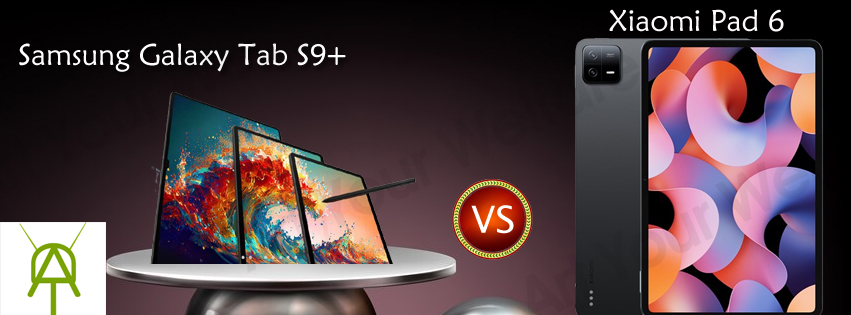Published on August 4, 2024
In the tablet era, there is always a clash between these two companies: Xiaomi and Samsung. Again, they are ready with their new beasts: Samsung with the Samsung Galaxy Tab S9+ and Xiaomi with the Xiaomi Pad 6. This time, it is the Samsung Galaxy Tab S9+ vs Xiaomi Pad 6 show. By deep-diving into their pros and cons, design, features, build quality, and pricing, we will help you find out who wins this comparison.
Tablet Display and Design Comparison: Samsung Galaxy Tab S9+ Vs Xiaomi Pad 6
Samsung and Xiaomi always try to innovate their displays and designs. This time, the Samsung Galaxy Tab S9+ comes with a massive 12.4-inch AMOLED display that provides a 120Hz super-fast screen refresh rate.
On the other hand, the Xiaomi Pad 6 has an 11-inch IPS LCD Screen and provides decent visuals, colors, and graphics, as its screen refresh rate is 60Hz, which is lower than the Samsung Galaxy Tab S9+.
Design-wise, the Samsung Galaxy Tab S9+ is lean and lightweight. It will offering a design on floating camera in her back side and it will gives a royal feel because it is built with premium-quality metal.
The Xiaomi Tab 6 body is made of aluminum metal, but it comes in many more variants than the Samsung Galaxy Tab S9+. In terms of design, it has sleek slates with slim frames from all the sides.
Performance
Being the two best tablets of 2024, Samsung Galaxy Tab S9+ and Xiaomi Pad 6 cannot afford any compromise in their performances. There is Qualcomm Snapdragon 8 Gen 2 in the Samsung Galaxy Tab S9+ model, which has 12 GB of RAM, as well as various sizes of inbuilt memory (up to 1 TB) starting from 128 GB.
The Xiaomi Pad 6 has a Snapdragon 870 and offers RAM options of 6 GB and 8 GB. However, it is beaten by the S9+ because it has only two storage options: 128 GB and 256 GB.
Operating System and Software
Both the Samsung Galaxy Tab S9+ and the Xiaomi Pad 6 come with the newest version of Android 14. However, Samsung offers its updates for a longer duration, compared with Xiaomi devices. It means the Samsung Galaxy Tab S9+ receives updates for a longer period.
Samsung Galaxy Tab S9+ comes with her own Samsung features that is One UI, its will very clean interface and options will customized . Whereas, the Xiaomi Pad 6 comes with a MIUI interface at the top of Android which is known for its rich experience with a distinct visual style.
Samsung Galaxy Tab S9+ comes with some pre-installed apps, like Galaxy Store, Samsung Notes, and Samsung Dex, while the other software may be useful or just a waste of storage. Xiaomi Pad 6 comes with some pre-installed apps, like an app store, gallery app, notes, and music player.
Camera and Multimedia
Talking about the Xiaomi Pad 6’s camera features and specs, this time, it will come with a 13-megapixel rear camera with an unknown sensor, and on the front side, there is an 8-megapixel sharp-shooting camera. Yet, the Samsung Galaxy Tab S9+ comes with a 13-megapixel main sensor and an additional 8-megapixel sensor. On the front side, there is a 12-megapixel selfie camera for clear video calls.
Both tables have a good-quality display that provides an amazing multimedia experience for movies, music, and calling. Both tablets support Dolby Atmos technology for enhanced surround sound, while the Samsung Galaxy Tab S9+ might boast superior speakers.

Battery Life
Both tablets have a heavy battery so that the user can enjoy games, video calls, and movies for a longer duration. The Samsung Galaxy Tab S9+ has a 10,070 mAh battery, which offers longer toleration for heavy tasks like, watching movies, video calling, scrolling reels, and gaming.
Whereas the Xiaomi Pad 6 has a battery capacity of around 8000 to 9000 mAh, which the company considers a decent battery for almost every user.
Samsung Galaxy Tab S9+ easily gives a backup of 9-10 hrs, whereas Xiaomi Pad 6 gives a backup of 7-8 hrs. Samsung Galaxy Tab S9+ and Xiaomi Pad 6 both devices come with super-fast charging.
Connectivity: Which Android tablet battery life and connectivity is Best?
Both tablets offer a good connectivity connection. This time Samsung Galaxy Tab S9+ comes with the latest Wi-Fi 6e standard, which allows users super-fasting downloading speed for downloading movies, uploading files, and playing online games.
Whereas, the Xiaomi Pad 6 likely utilizes Wi-Fi 6, which also gives excellent speed but does not reach the top potential of speed, like the Samsung Galaxy Tab S9+. Both tablets come with the latest 5.3 Bluetooth version to provide an amazing wireless headphones and speakers experience.
Samsung Galaxy Tab S9+ supports Samsung DeX, which allows users to connect the tablet to a monitor and use it like a desktop computer. Xiaomi Pad 6 also comes with NFC (Near Field Communication) as the means of contactless payments, media transfer, and data transfer.

Price and Value Comparison: Samsung Galaxy Tab S9+ vs Xiaomi Pad 6
The price on both devices has not yet announced on officially. A guess is that the Samsung Galaxy Tab S9+ could go around Rs.90,000 and the Xiaomi Pad 6. Is expected to retail at Rs.38,000 which is much cheaper than the S9+.
Both devices are value for money. If you want more features and a smoother experience, go with the Samsung Galaxy Tab S9+. If you are a normal user and want to complete your day-to-day tasks, you can go with a Xiaomi Pad 6.
Conclusion: Best budget tablet 2024
In any case, both tablets are good, it just fully depends on you, if you are a power user, work with multitasking, need a stylus, a larger battery, and an AMOLED screen – choose Samsung Galaxy Tab S9+. But, if you do not want to spend a significant amount of money and look for a decent feature, then go with Xiaomi Pad 6. But, when we look at the Galaxy Tab S9+ performance review, then it is better than the Xiaomi Pad 6 in terms of features, camera, and battery life.



